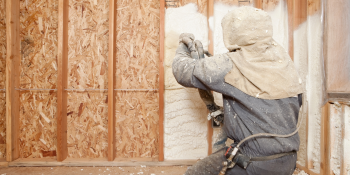Q&A Forums
Fall Protection Post New Topic | Post Reply
| Author | Comments |
|---|---|
|
Jeri Devlin
Posted: Jun 29, 2011 02:54 PM
|
Fall Protection
With OSHA rescinding the interim fall protection standard that allowed exceptions to conventional fall protection on residential jobsites, I am wondering if contractors are seeing or hearing of increased OSHA activity at residential sites and whether OSHA is citing applicators if not using conventional fall protection in attics.
|
|
jimcoler
I have over 10 years of experience specifying and installing open and closed cell spray foam. I've sold my business but I'm still selling for the new owners and consulting on large and custom specific jobs. I've expanded my knowledge into t Posted: Jun 29, 2011 05:16 PM
|
So, OSHA's job is to enforce the laws - no matter how rediculous they are. And that means that the earn money by writing fines. The state budget is hurting, the fed budget isn't much better and how do you expect them to be able to make up this difference? I've heard they've been around our area a couple of times on a couple of job sites, but haven't had the unlucky chance to meet them and I'm not complaining. |
|
mason
Posted: Jun 29, 2011 06:25 PM
|
OSHA is the only federal agency whose budget was not cut. They added hundreds of additional inspectors. The SPF residential insulation industry is on their hit list. (OSHA cannot police every industry, so they have a list of industries that they target every few years). The SPF industry is at the top of their list right now. So, be prepared, make sure you not only have the right equipment and procedures, but that you also have all the written documentation required, such as written safety program for your company and for each job, fire safety program, respirator program, haz mat program, document your safety training, and show that you have enforced compliance by disciplinary action of employees when needed. Coincidentally I am teaching an OSHA safety and health course for SPF applicators in the following locations Aug 15, San Diego Aug 19, Phoenix Aug 23, Denver Sept 23, Orland (in conjunction with ICAA annual conference Registration information is available at sustainablewp.org OR email at masonknowles@aol.com |
|
mason
Posted: Jul 01, 2011 11:20 AM
|
Specifically in residential attics, you can use an alternate form of fall protection (from what OSHA requires)only if the alternate form of fall protection is safer than what OSHA requires. In attics, you should have a written fall protection plan that eliminates the potential for falling through the drywall ceiling. I can think of a few ways 1. Nail down plywood over the floor joists in the area you are spraying and place caution tape off the areas you are not spraying, then have a safety monitor watching the applicators at all times. This in my opinion would be safer than having to constantly hook up and un hook a safety harness. (not to mention the problem of providing a place to hook up to.) |
|
Jeri Devlin
Posted: Jul 01, 2011 02:50 PM
|
thanks, Mason. This is a tough one. We were tying to use a plank across the trusses that we could slide as we moved in the attic. Now I don't think it would be acceptable. The thought of having the airline, the foam hose and a lifeline to an anchor all wound around an applicator in an attic is scarey. I tried to figure out how to do a fall restraint system to avoid freefall, rescue plan, & anchor for 5000#. I don't know if we always have room for a monitor in there and who stays with the rig? Do I have to put guardrails on the platform? Have they seen some of these attics?? What about retrofits? |
|
mason
Posted: Jul 01, 2011 04:35 PM
|
I think if you made a reasonable case against using conventional fall arrest systems in attics and provided a written plan that is safer, then OSHA would be more likely to accept it. I don't think they would accept the scaffold boards that you move from spot to spot. I think they would want a semi-permament work platform to spray from. Guard rails would not be needed presuming the plywood extended to the walls or knee walls. |
|
Doug Commette
Posted: Jul 02, 2011 05:45 AM
|
what is osha's position on using stilts? not that these work in every case, but i have seen them used successfully in many of them. just wondering what the rule is on them?? |
|
mason
Posted: Jul 02, 2011 11:50 AM
|
Stilts are OK without fall protection below 6 ft. Probably need head protection though. Here is the actual language of the OSHA fall protection for residential construction SUPPLEMENTARY INFORMATION: Background. Under 29 CFR 1926.501(b)(13), workers engaged in residential construction six (6) feet or more above lower levels generally must be protected by conventional fall protection i.e., guardrail systems, safety net systems, or personal fall arrest systems). However, if an employer can demonstrate that such fall protection is infeasible or presents a greater hazard, it may implement a written fall protection plan meeting the requirements of Sec. 1926.502(k). This is OSHA's citation policy Citation Policy. If an employer is engaged in residential construction, but does not provide guardrail systems, safety net systems, personal fall arrest systems, or other fall protection allowed under 1926.501(b), a citation for violating 1926.501(b)(13) should be issued unless the employer can demonstrate the infeasibility of these protective measures or the existence of a greater hazard. If the employer demonstrates infeasibility or a greater hazard, the CSHO must determine if the employer has implemented a fall protection plan meeting the requirements of 1926.502(k). Part of that determination will be based on whether the employer has instituted alternative measures to reduce or eliminate fall hazards. Under STD 03-00-001, the employer was not required to have a fall protection plan that was written and site-specific. With the cancellation of STD 03-00-001, fall protection plans under 1926.502(k) must be written and site-specific. If the fall protection plan is not written, site-specific, or otherwise fails to meet the requirements of 1926.502(k), the violation should be cited as a grouped citation of 1926.501(b)(13) and 1926.502(k). A written plan developed for repetitive use for a particular style/model home will be considered site-specific with respect to a particular site only if it fully addresses all issues related to fall protection at that site. See CPL 02-00-111, Citation Policy for Paperwork and Written Program Requirement Violations, November 27, 1995, for additional guidance when citing violations of the requirement for a written fall protection plan in 1926.501(b)(13) and 1926.502(k). protection (i.e., guardrail systems, safety net systems, or personal fall arrest systems). However, if an employer can demonstrate that such fall protection is infeasible or presents a greater hazard, it may implement a written fall protection plan meeting the requirements of Sec. 1926.502(k). |
|
Posted: Jul 02, 2011 05:07 PM
|
..and certainly the same scrutiny is being given to the fiberglass and cellulose and electrcial and hvac folks who have to work in the attic assemblies???? i just want to be sure we are all being leveled the same "eyeballs" cause golly gee its gonna be tough tinkerbellin around in those attics with the filterglass fellas,,,reality,,, layin down deck boards in a trussed attic??? yeah right,,,and can you do it cheap??? bang bang,,shoot shoot,,,one bullet barney??? or was that two??? |
|
Jeri Devlin
Posted: Jul 05, 2011 08:56 AM
|
from OSHA interpretation letter: "With regard to stilts, please be advised that OSHA regulations do not prohibit their use. In addition, OSHA has no plans to prohibit them. It should be stressed that where standard guardrails are used to protect employees working near an edge, the height of the guardrails may have to be raised if stilts are to be used." Another letter from OSHA stated that stilts are not prohibited, but could be a violation if used unsafely (debris on floor, floor holes not covered, etc.) I had found some OSHA rules on stilts a few years back and will try and find it again. There are a few rules in 1926.452 (y). |





























